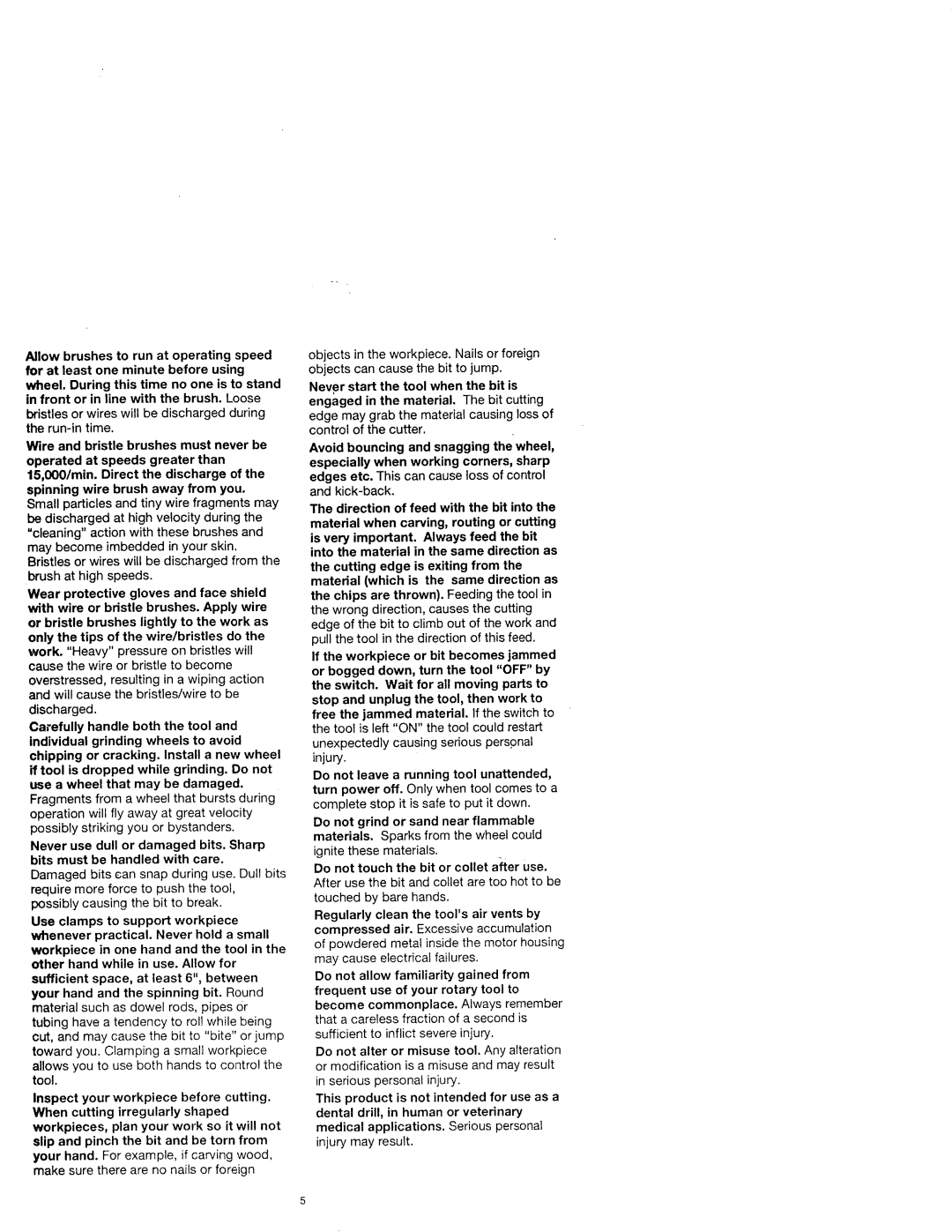
Allow brushes to run at operating speed for at least one minute before using wheel. During this time no one is to stand in front or in line with the brush. Loose
bristles or wires will be discharged during the
Wire and bristle brushes must never be operated at speeds greater than 15,000/min. Direct the discharge of the spinning wire brush away from you.
Small particles and tiny wire fragments may be discharged at high velocity during the "cleaning" action with these brushes and may become imbedded in your skin.
Bristles or wires will be discharged from the brush at high speeds.
Wear protective gloves and face shield with wire or bristle brushes. Apply wire
or bristle brushes lightly to the work as only the tips of the wire/bristles do the
work. "Heavy" pressure on bristles will cause the wire or bristle to become
overstressed, resulting in a wiping action and will cause the bristles/wire to be discharged.
Carefully handle both the tool and individual grinding wheels to avoid chipping or cracking. Install a new wheel if tool is dropped while grinding. Do not use a wheel that may be damaged. Fragments from a wheel that bursts during operation will fly away at great velocity possibly striking you or bystanders.
Never use dull or damaged bits. Sharp bits must be handled with care.
Damaged bits
Use clamps to support workpiece whenever practical. Never hold a small
workpiece in one hand and the tool in the other hand while in use. Allow for
sufficient space, at least 6", between
your hand and the spinning bit. Round material such as dowel rods, pipes Or
tubing have a tendency to rol! while being cut, and may cause the bit to "bite" or jump toward you. Clamping a small workpiece allows you to use both hands to control the tool.
Inspect your workpiece before cutting. When cutting irregularly shaped workpieces, plan your work so it will not slip and pinch the bit and be torn from your hand. For example, if carving wood, make sure there are no nails or foreign
objects in the workpiece. Nails or foreign objects can cause the bit to jump.
Never start the tool when the bit is engaged in the material. The bit cutting edge may grab the material causing loss of control of the cutter.
Avoid bouncing and snagging the wheel, especially when working corners, sharp edges etc. This can cause loss of control and
The direction of feed with the bit into the
material when carving, routing or cutting is very important. Always feed the bit into the material in the same direction as the cutting edge is exiting from the material (which is the same direction as the chips are thrown). Feeding the tool in the wrong direction, causes the cutting
edge of the bit to climb out of the work and pull the tool in the direction of this feed.
If the workpiece or bit becomes jammed or bogged down, turn the tool "OFF" by the switch. Wait for all moving parts to stop and unplug the tool, then work to free the jammed material. If the switch to the tool is left "ON" the tool could restart unexpectedly causing serious perspnal injury.
Do not leave a running tool unattended, turn power off. Only when tool comes to a complete stop it is safe to put it down.
Do not grind or sand near flammable materials. Sparks from the wheel could ignite these materials.
Do not touch the bit or collet after use.
After use the bit and collet are too hot to be
touched by bare hands.
Regularly clean the tool's air vents by compressed air. Excessive accumulation
of powdered metal inside the motor housing may cause electrical failures.
Do not allow familiarity gained from
frequent use of your rotary tool to
become commonplace. Always remember that a careless fraction of a second is sufficient to inflict severe injury.
Do not alter or misuse tool. Any alteration or modification is a misuse and may result
in serious personal injury.
This product is not intended for use as a dental drill, in human or veterinary
medical applications. Serious personal injury may result.
